Seal of the President of the Philippines
The Seal of the President of the Philippines (Filipino: Sagisag ng Pangulo ng Pilipinas) is a symbol used to represent the history and dignity of the President of the Philippines. Its original form was designed by Captain Galo B. Ocampo, Secretary of the Philippine Heraldry Committee, and patterned after the Seal of the President of the United States.[1] It was first used by President Manuel Roxas in 1947.
| Seal of the President of the Philippines Sagisag ng Pangulo ng Pilipinas | |
|---|---|
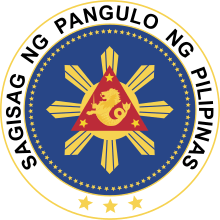 | |
| Versions | |
 The coat of arms of the President of the Philippines as defined by Executive Order No. 310 of 2004 | |
| Armiger | President of the Philippines |
| Adopted | 1947 (current definition from 2004) |
| Blazon | A circular blue shield with an eight-rayed golden-yellow Philippine sun at the center. Overlapping the Philippine sun is a red equilateral triangle. Inside and at the center of the equilateral triangle is the traditional golden-yellow sea lion (Ultramar) of the Coat-of-Arms granted to the City of Manila in 1596, on guard with a sword on its right paw, at hilt. Inside and at the corner of each of the three (3) angles of the equilateral triangle, a five-pointed golden-yellow star to represent Luzon, Visayas, and Mindanao, respectively. |
| Other elements | The whole are encircled at the outer edge of the blue shield by five-pointed golden-yellow stars, with one point of each star pointing outward on the imaginary radiating center lines, the number of stars conforming to the number of provinces of the Republic of the Philippines at any given time. |
| Use | On documents from the President to members of government, and as a symbol on presidential vehicles, podiums, and other places |
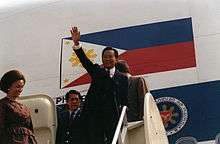

Description and Symbolism
The seal is composed of the coat of arms of the president, which, according to Executive Order № 310 of 2004 consists of:
A circular blue shield with an eight-rayed golden-yellow Philippine sun at the center. Overlapping the Philippine sun is a red equilateral triangle. Inside and at the center of the equilateral triangle is the traditional golden-yellow sea lion (Utramar) of the Coat-Of-Arms granted to the City of Manila in 1596, on guard with a sword on its right paw, at hilt.
Inside and at the corner of each of the three (3) angles of the equilateral triangle, a five-pointed golden-yellow star to represent Luzon, Visayas, and Mindanao, respectively.
The elements enumerated above are encircled at the outer edge of the blue shield by five-pointed golden-yellow stars, with one point of each star pointing outward on the imaginary radiating center lines, the number of stars conforming to the number of provinces of the Republic of the Philippines at any given time.
The Seal of the President of the Philippines shall consist of the Coat-Of-Arms of the President of the Philippines, and a white circle around the Coat-of-Arms enclosed by two (2) golden-yellow marginal rings. The white circle shall contain the words SAGISAG NG PANGULO NG PILIPINAS ("Seal of the President of the Philippines") in black letters on the upper arc, the lower arc divided by three (3) five-pointed golden-yellow stars.
Some of the symbols in the arms are derived from the National Flag, and retain their meaning. The eight-rayed sun represent the eight provinces placed under martial law in 1896 at the onset of the Philippine Revolution. On the sun there is an equilateral triangle (colored red as opposed to the Flag's white), representing liberty, equality, and fraternity, which were ideals of the Revolution. The stars at the corners of the triangle represent the three major island groups of Luzón, Visayas and Mindanao.
At the center of the coat-of-arms is a Sea-lion, which is derived from the coat-of-arms of the City of Manila granted by Philip II of Spain in 1596. It has the upper half of a lion, and the lower half and curled tail of a fish. The Sea-lion as a heraldic device ultimately comes from the lion on the coat-of-arms of Castile and León; since the islands were an overseas (ultramar) possession, the lion became a sea lion.
History
The seal was first used by President Manuel Roxas in 1947. It was designed by Captain Galo B. Ocampo of the Philippine Heraldry Committee, who also designed the Coat of arms of the Philippines. The Seal was officially prescribed on January 7, 1947, when Executive Order № 38 of 1947 was signed into law. It prescribed the coat of arms and seal of the President as:
SECTION 1. The coat of arms of the President of the Philippines shall be of the following design:
SHIELD: The eight-rayed Philippine sun rayonnant in or; on the center an equilateral triangle in gules; over-all the traditional sea lion (Ultramar) of the ancient or original coat of arms of the City of Manila on guard with sword or at hilt; on three points of triangle three mullets in or.
SEC. 2. The seal of the President of the Philippines shall consist of the coat of arms of the President of the Philippines encircled by the words “Seal of the President of the Philippines”.
On July 4, 1951, President Elpidio Quirino, signed Executive Order № 457 into law prescribing that:
...the color of the sun and the sea lion shall be in golden yellow and, additionally provide that the design shall be surrounded by stars forming an amulet in a number equivalent to the number of provinces of the Republic as of July 4, 1951.
At the time of signing, the Philippines had 52 provinces.
On August 27, 1998, President Joseph Estrada signed Executive Order № 19, amending Executive Order № 38 of 1947 (as amended) in view of the fact that 1951, the number of provinces has increased to 78 and that there is a need to synchronize the number of stars to match the number of provinces at a given time.
After Estrada's Executive Order came into law, Roxas's Executive Order read:
Shield: the eight-rayed Philippine sun ravonnant in golden yellow; on the center, an equilateral triangle in gules (red); overall the traditional sea lion of the Coat of Arms granted to the City of Manila in 1596, on guard with sword, or at hilt and one mullet in golden yellow in the corner of each of the three angles of the equilateral triangle: one mullet representing Luzon; one, Visayas; and another, Mindanao. The whole, surrounded by stars in the form of an amulet with one point of each star outward on the imaginary radiating center lines, the number of stars conforming to the number of provinces of the Republic at any given time.
On April 20, 2004, President Gloria Macapagal Arroyo signed Executive Order № 310, which standardized the Seal and its derivative material. The Seal as it appears on government documents and property has since been redesigned to conform with the Executive Order.
Evolution of the Presidential Seal
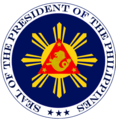 The first seal, with the text SEAL OF THE PRESIDENT OF THE PHILIPPINES. This version was used in 1947 - 1951.
The first seal, with the text SEAL OF THE PRESIDENT OF THE PHILIPPINES. This version was used in 1947 - 1951.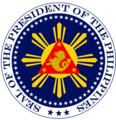 The Presidential seal dated 1965 . The ring of stars surrounding the presidential coat of arms was added in 1951.
The Presidential seal dated 1965 . The ring of stars surrounding the presidential coat of arms was added in 1951.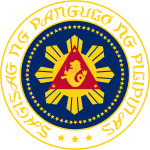 A 1969 instance of the Seal. The English text was changed to "SAGISAG NG PANGULO NG PILIPINAS" at an unspecified time between 1965 and 1969, during the term of Ferdinand Marcos.
A 1969 instance of the Seal. The English text was changed to "SAGISAG NG PANGULO NG PILIPINAS" at an unspecified time between 1965 and 1969, during the term of Ferdinand Marcos.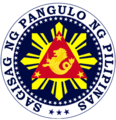 One of the presidential seals of President Ferdinand Marcos. This seal was used last 1974?
One of the presidential seals of President Ferdinand Marcos. This seal was used last 1974?.svg.png) An alternate version of the 1981 seal. The triangle was inverted, and the Sea-lion of Manila was changed to an eagle. The text would also be in script and, together with the ring of stars set against the circular field, are rendered in gold color.
An alternate version of the 1981 seal. The triangle was inverted, and the Sea-lion of Manila was changed to an eagle. The text would also be in script and, together with the ring of stars set against the circular field, are rendered in gold color.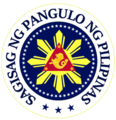 Under the government of President Corazon Aquino, the seal was restored to the Galo Ocampo original but with Filipino text; this seal would be in general use.
Under the government of President Corazon Aquino, the seal was restored to the Galo Ocampo original but with Filipino text; this seal would be in general use. Present Presidential seal as prescribed by Executive Order No. 310, which was signed into law on April 20, 2004.
Present Presidential seal as prescribed by Executive Order No. 310, which was signed into law on April 20, 2004.
See also
| Wikisource has original text related to this article: |
References
- Executive Order No. 310, Manuel L. Quezon III, May 29, 2005
- Executive Order No. 38, s. 1947 Official Gazette
- Executive Order No. 457, s. 1951 Official Gazette
- Executive Order No. 19, s. 1998 Official Gazette
- Executive Order No. 310, s. 2004 Official Gazette
- The Presidential Seal
- Philippines: President and Vice President
- A presentation box with the Presidential Seal, circa 1969: "This seal predates the (1981) change in the presidential seal ordered by Ferdinand Marcos during his tenure as president."